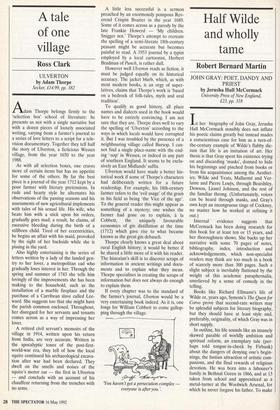Half Wilde and wholly tame
Robert Bernard Martin
JOHN GRAY: POET, DANDY AND PRIEST by Jerusha Hull McCormack University Press of New England, £23, pp. 318 In her biography of John Gray, Jerusha Hall McCormack sensibly does not inflate his poetic claims greatly but instead mades a conscientious case for him as a turn-of- the-century example of Wilde's flabby dic- tum that life is an imitation of art. Her thesis is that Gray spent his existence trying on and discarding 'masks', donned to hide his beginnings and pinched from books or from his acquaintance among the Aesthet- ics; Wilde and Yeats, Mallarme and Ver- laine and Pierre Louys, through Beardsley, Dowson, Lionel Johnson, and the rest of the familiar throng. (Unfortunately, voices can be heard through masks, and Gray's own kept an incongruous tinge of Cockney, no matter how he worked at refining it out.)
Internal evidence suggests that McCormack has been doing research for this book for at least ten or 15 years, and her thoroughness shows. She backs up her narrative with some 70 pages of notes, bibliography, index, introduction and acknowledgements, which non-specialist readers may think are too much in a book of scarcely more than 300 pages. Such a slight subject is inevitably flattened by the weight of this academic paraphernalia, unrelieved by a sense of comedy in the telling.
Books like Richard Ellmann's life of Wilde or, years ago, Symons's The Quest for Corvo prove that second-rate writers may be splendid subjects for literary biography, but they should have at least style and, preferably, originality, of which Gray was in short supply.
In outline, his life sounds like an insanely skewed parable of worldly ambition and spiritual reform, an exemplary tale (per- haps told tongue-in-cheek by Firbank) about the dangers of denying one's begin- nings, the fustian attraction of artistic com- panions, and the final rewards of religious devotion. He was born into a labourer's family in Bethnal Green in 1866, and at 13 taken from school and apprenticed as a metal-turner at the Woolwich Arsenal, for which he never forgave his father. To make
up for his lack of education he sweated at his studies at night, and by open examina- tion won a place in the Civil Service, then matriculation in the University of London (he never took up the option), and finally a place in the Foreign Office Library when he was 27.
Out of library hours there was a more flamboyant side to his life, for he had fallen under the influence of the Aesthetics in his early twenties, copying both their poetic theories and their predilection for homo- sexuality. He was following what might be described as one of their fads when, with- out much conviction, he became a Roman Catholic convert in 1890.
As one might expect from a minor fol- lower of a minor movement, his best poetry has an occasional mild astringency but is more often a curious blend of attenuated religious sexuality and relentless rhymes that make one cringe in anticipation.
The most conspicuous of the admirers of his slender talent and lyric profile was Oscar Wilde, who was widely believed to have used him as model for Dorian Gray. John Gray encouraged the rumour, although he knew it was not strictly true. McCormack hesitates about the matter, at first agreeing that he was 'in some sense' Wilde's original, then more plausibly sug- gesting that real-life John annexed fictional Dorian as a 'mask' in transforming himself into a dandy.
Two or three years after meeting Gray, Wilde came across an appealing youth with weak good looks reminiscent of Gray's own: Lord Alfred Douglas. From the time Oscar met Bosie is was all up with Gray. In his sense of desertion, he threatened sui- cide but was rescued by another patron, a rich and artistic Russian émigré, Andre Raffalovich, chiefly known as a propagan- dist of `Uranism'. Raffalovich set him up in lodgings in Park Lane, only a short stroll from his own house in South Audley Street, where they began 42 years of associ- ation that seems, like many more conven- tional marriages, to have shaded off from sexual involvement to primly respectable companionship.
When it became clear that Wilde could not escape public scandal, Gray quickly dis- engaged himself from the circles he had frequented at the Rhymers' Club and the Café Royal, and in the process of sanitising his reputation found the piety that had eluded him at conversion. He went to Rome to study for the priesthood at the Scots College, then settled down as a parish priest in Edinburgh for the second, and more humdrum, half of his life.
Raffalovich, by now a Roman Catholic too, built him a church of his own in Edin- burgh. Gray visited his parishioners, drove with Raffalovich in his barouche, regularly went to his house for a conventional Sun- day luncheon, took a fortnight annually to walk' in the Cotswolds (with a limousine and driver to ferry him and Raffalovich around those gentle hills), and he made translations and wrote delicious little medi- tations 'on the social intricacies of leave- taking'. It was a long way from Bethnal Green, and it sounds even less fun. At the end of his life he became Canon Gray.
It is only fair to say that his mildly exper- imental poetry improved as he got older, but not enough, for there was a fatal lack of gravel in his craw. Although this biogra- phy documents his external existence accu- rately, the available sources are probably insufficient to reflect much of his interior life, and he emerges as a shallow, shadowy figure with little to engage us, hardly worth this skilful exhumation. Perhaps, as McCormack speculates herself, 'there is actually no "John Gray" who exists apart from his roles'.
Robert Bernard Martin's most recent book, Gerard Manley Hopkins: A Very Private Life, is available in paperback (Flamingo, f6.99).



















































 Previous page
Previous page